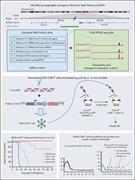Issue Archive
Table of Contents
BLOOD COMMENTARIES
REVIEW ARTICLE
Targeting biased signaling by PAR1: function and molecular mechanism of parmodulins
Protease-activated receptor-1 (PAR1) is a 7 transmembrane, G protein–coupled receptor expressed by endothelial cells that is a therapeutic target for cardiovascular disease, as it mediates thrombin-dependent platelet activation. PAR1 activation depends on proteolytic cleavage, and PAR-1 signaling can be biased, depending on how it is cleaved. New agents targeting PAR1, parmodulins, exploit this to selectively affect PAR1 signaling for therapeutic benefit. Künze and Isermann review the discovery, structure, mechanism of activity, and potential clinical use of parmodulins.
HOW I TREAT
How I diagnose and treat neonatal thrombocytopenia
Using illustrative cases, Stanworth and Mumford explore the current thinking about how best to diagnose and, when appropriate, treat thrombocytopenia in neonates. This is a common scenario in neonatal intensive care units and can be self-limiting and mild or life-threatening. The authors discuss the current classification and how it helps guide action, as well as outline judicious use of transfusions.
GENE THERAPY
Novel extragenic genomic safe harbors for precise therapeutic T-cell engineering
Targeted integration of chimeric antigen receptor (CAR) transgenes in defined genetic locations is anticipated to improve sustained expression and reduce risks associated with conventional gene transfer methods, such as insertional mutagenesis. Using a CRISPR-Cas9–assisted knock-in technique, Odak et al investigated locations in the noncoding genome that provide stable expression of CAR transgenes in human T cells, identifying GSH6 as such a site that can achieve long-term tumor control. The authors’ data expand our ability to engineer potent CAR T-cell products and provide resources for the identification of other extragenic genomic safe harbor locations.
IMMUNOBIOLOGY AND IMMUNOTHERAPY
DOCK11 deficiency in patients with X-linked actinopathy and autoimmunity
Dedicator of cytokinesis (DOCK) proteins play important roles in actin cytoskeleton regulation, and immune disorders have been described for deficiencies of some DOCK proteins. Boussard et al identify 8 male patients with a new X-linked actinopathy characterized by impaired CDC42 activity, abnormal actin cytoskeleton remodeling of immune cells, and early onset autoimmunity.
LYMPHOID NEOPLASIA
Improved outcomes for relapsed/refractory Hodgkin lymphoma after autologous transplantation in the era of novel agents
Clinical Trials & Observations
Spinner and colleagues examined outcomes in patients with relapsed classic Hodgkin lymphoma who underwent autologous stem cell transplantation (ASCT) in the modern era (2011-2020) compared to those treated in the prior decade before the availability of brentuximab vedotin and PD-1 inhibitors. The authors found a significant improvement in 4-year overall survival in the modern era: 89.1% vs 79.0%, respectively. In a multivariable analysis, receipt of a PD-1 inhibitor prior to ASCT associates with improved survival while the 4-year survival of patients with recurrent disease after ASCT is improved from 43.3% to 71.4%, most likely related to more effective salvage with these new agents.
MYELOID NEOPLASIA
A single-cell atlas identifies pretreatment features of primary imatinib resistance in chronic myeloid leukemia
Krishnan et al describe a single-cell transcriptomic atlas of chronic myeloid leukemia bone marrow at diagnosis. By comparing groups with varying degrees of response or initial treatment failure on imatinib, the authors identified features at diagnosis predictive of response to tyrosine kinase inhibitor (TKI) therapy. These include gene expression signatures within leukemic stem cells and natural killer (NK) cells and a correlation of expansion of a normally rare subset of hyperfunctional adaptive-like NK cells (CD57+NKG2C+) with TKI response. An antibody panel is described to assist future translation of these findings into practice.
RED CELLS, IRON, AND ERYTHROPOIESIS
TRANSPLANTATION
Prognostic value of blood biomarkers in steroid-refractory or steroid-dependent acute graft-versus-host disease: a REACH2 analysis
Socié and colleagues report on the prognostic value of 12 biomarkers for predicting treatment response of steroid-refractory and steroid-dependent acute graft-versus-host disease (GVHD) at day 28 to second-line therapy, using data from the randomized trial of ruxolitinib vs best available care. The authors identified ruxolitinib therapy, nonmyeloablative conditioning, skin GVHD, and lower age as associated with increased likelihood of response and utilized cellular and cytokine biomarkers to develop clinically useful predictive models.
LETTER TO BLOOD
Nivolumab combined with brentuximab vedotin for relapsed/refractory mediastinal gray zone lymphoma
Clinical Trials & Observations
Mediastinal gray zone lymphoma (MGZL) is a rare subtype of aggressive non-Hodgkin lymphoma which has CD30 antigen expression and upregulation of the PD1 pathway. Santoro and colleagues report on a prospective trial of the anti-CD30 antibody brentuximab vedotin with the anti-PD1 antibody nivolumab in 10 patients with relapsed MGZL, documenting a 70% response rate with 50% complete responses. These data highlight the efficacy of novel therapy in the setting of relapsed/refractory disease and its potential to bridge patients toward curative stem cell transplant.
BLOOD WORK
ERRATA
-
Cover Image
Cover Image
![issue cover]()
Dedicator of cytokinesis 11 deficiency is associated with aberrant lymphocyte morphology and increased size. Abnormal filopodiumlike structures and 1-axis spreading protrusion are observed on the patients’ lymphocytes. F-actin is stained in red with phalloidin, and the nucleus is stained in blue with DAPI. See the article by Boussard et al on page 2713.
- PDF Icon Front MatterFront Matter
- PDF Icon Table of ContentsTable of Contents
- PDF Icon Back MatterBack Matter
- PDF Icon Editorial BoardEditorial Board
Advertisement intended for health care professionals
Email alerts
Advertisement intended for health care professionals











Splendid isolation